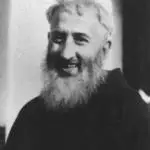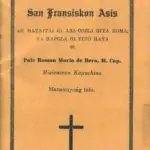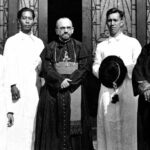Father Roman de Vera
Table of Contents
Share This
Pioneer promoter of the CHamoru language
Father Roman Maria de Vera (1878 – 1959), a Catholic missionary on Guam from 1915 until 1941, was one of the first important writers in the CHamoru/Chamorro language. Prior to him, there was only a handful of literature published in CHamoru. Because the overwhelming majority of CHamorus at the time were Catholic, de Vera’s religious works in CHamoru were widely read and became the norm for many in CHamoru orthography.
Early Life
De Vera was born on 9 August 1878 in the town of Vera de Bidasoa, Navarra, Spain. His civil name was Roman Dornacu Olaechea. The Catholic Church, especially in its missionary endeavors, was a strong social force in Navarra, which was historically and culturally a Basque region of Spain. In his early teens, Roman conceived the idea of becoming a Catholic missionary in foreign lands.
In light of this desire, de Vera joined the missionary arm of the Capuchin Franciscan Order in Spain, called the District Nullius. As a Capuchin friar, he dropped his surname and was known from then on as Roman de Vera, after his birthplace. The District Nullius was charged with sending Spanish Capuchin missionaries overseas with financial help from the Spanish Government. Biographies of de Vera state that he was particularly suited for missionary work, being robust in health and gifted in languages.
On 15 May 1901, he was ordained a priest and sent to the missions in the Philippines.
Missionary in the Philippines
De Vera’s work as a young priest in the Philippines quickly evinced the two main spheres of his life’s mission: linguist and apologist. De Vera quickly learned to speak and write in the Tagalog, Pampango and Bicol dialects. In 1904, he published in Manila a Spanish-Bicol grammar entitled “Gramatica Hispano-bicol seg’ n el metodo de Allendorf.” He also spent time in the Philippines perfecting his grasp of English.
Armed with his fluency in the local languages, de Vera set about preaching a defense of the Catholic faith, then strongly attacked by various quarters in Philippine society. In this, de Vera continued what had been a characteristic Capuchin tradition, which was the popularization of Catholic apologetics among the rural and working classes. He was called on by several bishops in the Philippines to work in their respective dioceses. Some areas he worked in were Manila, Sariaya, Corregidor, Bataan, Pasay, Malabon, Tayabas and Lucena. From 1908 until 1915, when the Philippine Mission was assigned to a different Capuchin jurisdiction, de Vera returned to his native Spain.
Mission work on Guam
On 30 April 1915, de Vera began his 26-year assignment on Guam. He quickly became the acknowledged expert in the CHamoru language among the Catholic missionaries. All missionaries after him had to learn the language from de Vera and pass a final test by him before they were allowed to minister among the people.
As literacy increased in Guam, de Vera appreciated the importance of publishing religious works in CHamoru. By the end of his tenure on Guam, he had translated more than 30 religious works into CHamoru, the first being printed in 1920, five years after his arrival. This was the largest output of literature in CHamoru produced by any individual up to that time, and for many years afterwards. He also published a CHamoru-Spanish dictionary in 1932.
Besides his literary work, de Vera became an influential social force through his preaching in the CHamoru language, made frequent visits to homes and hospitals, and had wide social contacts among all levels of CHamoru society. In 1920, he undertook a census of Hagåtña which included many outlying villages. During the influenza epidemic of 1918, de Vera took the leadership in visiting the sick and burying the dead. For these efforts, he was given a special commendation by US President Woodrow Wilson.
Final Years
In 1941 the last Spanish missionaries on Guam were replaced by American missionaries. De Vera, whose presence was so crucial to the Church on Guam, was in the last group to leave. He resettled in Manila until 1950 when he definitively moved to Spain, where he died on 26 November 1959.
Promoted the CHamoru Language
De Vera’s contribution to the promotion of the CHamoru language goes beyond the number of publications he authored in the language. De Vera ensured the wide availability of literature in the language and helped people improve in their grasp of the language.
De Vera was committed to promoting the authentic CHamoru word, rather than a borrowing from Spanish, even if the authentic CHamoru word had become archaic. This is evidenced by his choice of words in his translations, and by his CHamoru-Spanish dictionary. Many CHamoru words which would have fallen into disuse and obscurity have thus been preserved for future generations.
Nobenan San Fransiskon Asis
View more nobena e-Publications here.
For further reading
“Father Roman-RIP.” Umatuna si Yu’us, 13 December 1959.
“Román María de Vera.” Boletín Oficial de la Provincia Capuchina de Navarra-Cantabria-Aragón 15, 1960: 48-53.
Sinajaña, Eric de, OFM Cap. Historia de la Misión de Guam de los Capuchinos Españoles. Pamplona: Curia Provincial de los Capuchinos, 2001.
Sullivan, Julius, OFM Cap. The Phoenix Rises: A Mission History of Guam. New York: Seraphic Mass Association, 1957.
“Twenty-two Years in Guam.” Guam Recorder, May 1937.



